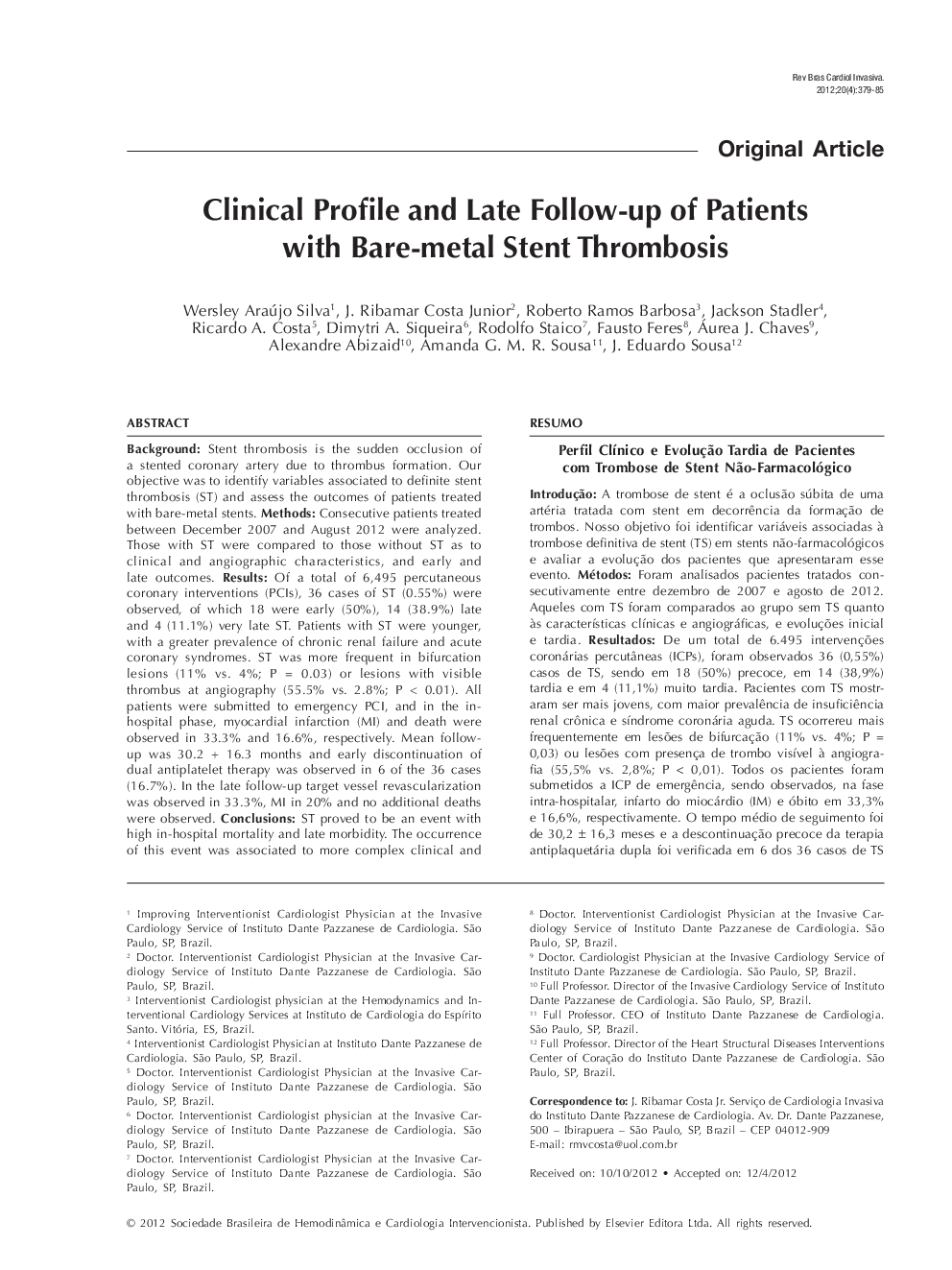| Article ID | Journal | Published Year | Pages | File Type |
|---|---|---|---|---|
| 3011770 | Revista Brasileira de Cardiologia Invasiva (English Edition) | 2012 | 7 Pages |
ABSTRACTBackgroundStent thrombosis is the sudden occlusion of a stented coronary artery due to thrombus formation. Our objective was to identify variables associated to definite stent thrombosis (ST) and assess the outcomes of patients treated with bare-metal stents.MethodsConsecutive patients treated between December 2007 and August 2012 were analyzed. Those with ST were compared to those without ST as to clinical and angiographic characteristics, and early and late outcomes.ResultsOf a total of 6,495 percutaneous coronary interventions (PCIs), 36 cases of ST (0.55%) were observed, of which 18 were early (50%), 14 (38.9%) late and 4 (11.1%) very late ST. Patients with ST were younger, with a greater prevalence of chronic renal failure and acute coronary syndromes. ST was more frequent in bifurcation lesions (11% vs. 4%; P = 0.03) or lesions with visible thrombus at angiography (55.5% vs. 2.8%; P < 0.01). All patients were submitted to emergency PCI, and in the inhospital phase, myocardial infarction (MI) and death were observed in 33.3% and 16.6%, respectively. Mean followup was 30.2 + 16.3 months and early discontinuation of dual antiplatelet therapy was observed in 6 of the 36 cases (16.7%). In the late follow-up target vessel revascularization was observed in 33.3%, MI in 20% and no additional deaths were observed.ConclusionsST proved to be an event with high in-hospital mortality and late morbidity. The occurrence of this event was associated to more complex clinical and angiographic characteristics and lower compliance with dual antiplatelet therapy.
RESUMOPerfil Clínico e Evolução Tardia de Pacientescom Trombose de Stent Não-FarmacológicoIntroduçãoA trombose de stent é a oclusão súbita de uma artéria tratada com stent em decorrência da formação de trombos. Nosso objetivo foi identificar variáveis associadas à trombose definitiva de stent (TS) em stents não-farmacológicos e avaliar a evolução dos pacientes que apresentaram esse evento.MétodosForam analisados pacientes tratados consecutivamente entre dezembro de 2007 e agosto de 2012. Aqueles com TS foram comparados ao grupo sem TS quanto às características clínicas e angiográficas, e evoluções inicial e tardia.ResultadosDe um total de 6.495 intervenções coronárias percutâneas (ICPs), foram observados 36 (0,55%) casos de TS, sendo em 18 (50%) precoce, em 14 (38,9%) tardia e em 4 (11,1%) muito tardia. Pacientes com TS mostraram ser mais jovens, com maior prevalência de insuficiência renal crônica e síndrome coronária aguda. TS ocorrereu mais frequentemente em lesões de bifurcação (11% vs. 4%; P = 0,03) ou lesões com presença de trombo visível à angiografia (55,5% vs. 2,8%; P < 0,01). Todos os pacientes foram submetidos a ICP de emergência, sendo observados, na fase intra-hospitalar, infarto do miocárdio (IM) e óbito em 33,3% e 16,6%, respectivamente. O tempo médio de seguimento foi de 30,2 ± 16,3 meses e a descontinuação precoce da terapia antiplaquetária dupla foi verificada em 6 dos 36 casos de TS (16,7%). Na evolução tardia observou-se revascularização do vaso-alvo em 33,3%, IM em 20% e nenhum óbito adicional.ConclusõesA TS mostrou ser evento com elevada mortalidade hospitalar e alta morbidade tardia. A ocorrência desse evento foi associada a características clínicas e angiográficas de maior complexidade e a menor aderência à terapêutica antiagregante dupla.
